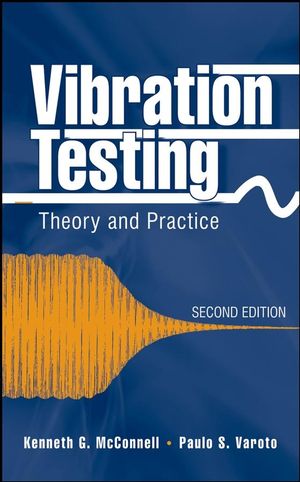Vibration Testing: Theory and Practice, 2nd EditionISBN: 978-0-471-66651-6
Hardcover
672 pages
October 2008
 This is a Print-on-Demand title. It will be printed specifically to fill your order. Please allow an additional 10-15 days delivery time. The book is not returnable.
|
||||||
Preface xix
1. An Overview of Vibration Testing 1
1.1 Introduction 2
1.2 Preliminary Considerations 6
1.3 General Input-Output Relationships in the Frequency Domain 8
1.4 Overview of Equipment Employed 10
1.5 Summary 12
2. Dynamic Signal Analysis 13
2.1 Introduction 14
2.2 Phasor Representation of Periodic Functions 21
2.3 Periodic Time Histories 26
2.4 Transient Signal Analysis 32
2.5 Correlation Concepts—A Statistical Point of View 38
2.6 Correlation Concepts—Periodic Time Histories 40
2.7 Correlation Concepts—Transient Time Histories 47
2.8 Correlation Concepts—Random Time Histories 50
2.9 Summary 63
2.10 General References on Signal Analysis 65
3. Vibration Concepts 67
3.1 Introduction 68
3.2 The Single DOF Model 68
3.3 Single Degree of Freedom Forced Response 76
3.4 General Input-Output Model For Linear Systems 88
3.5 The Two Degrees of Freedom Vibration Model 101
3.6 The Second-Order Continuous Vibration Model 115
3.7 Fourth-Order Continuous Vibration System—The Beam 130
3.8 Nonlinear Behavior 143
3.9 Summary 156
3.10 References 161
4. Transducer Measurement Considerations 164
4.1 Introduction 164
4.2 Fixed Reference Transducers 166
4.3 Mechanical Model of Seismic Transducers—The Accelerometer 173
4.4 Piezoelectric Sensor Characteristics 180
4.5 Combined Linear and Angular Accelerometers 193
4.6 Transducer Response to Transient Inputs 199
4.7 Accelerometer Cross-Axis Sensitivity 212
4.8 The Force Transducer General Model 222
4.9 Correcting FRF Data for Force Transducer Mass Loading 235
4.10 Calibration 246
4.11 Environmental Factors 263
4.12 Summary 267
5. The Digital Frequency Analyzer 272
5.1 Introduction 272
5.2 Basic Processes of a Digital Frequency Analyzer 274
5.3 Digital Analyzer Operating Principles 289
5.4 Factors in the Application of a Single-Channel Analyzer 296
5.5 The Dual-Channel Analyzer 314
5.6 The Effects of Signal Noise on FRF Measurements 326
5.7 Overlapping Signal Analysis to Reduce Analysis Time 339
5.8 Zoom Analysis 348
5.9 Scan Analysis, Scan Averaging, and More on Spectral Smearing 359
5.10 Summary 368
6. Vibration Excitation Mechanisms 374
6.1 Introduction 375
6.2 Mechanical Vibration Exciters 382
6.3 Electrohydraulic Exciters 394
6.4 The Modeling of an Electro Magnetic Vibration Exciter System 403
6.5 An Exciter System’s Bare Table Characteristics 419
6.6 Interaction of An Exciter and a Grounded Single DOF Structure 426
6.7 Interaction of an Exciter and an Ungrounded Structure Under Test 438
6.8 Measuring An Exciter’s Actual Characteristics 449
6.9 Summary 460
7. The Application of Basic Concepts to Vibration Testing 465
7.1 Introduction 466
7.2 Sudden Release Or Step Relaxation Method 468
7.3 Forced Response of a Simply Supported Beam Mounted on an Exciter 485
7.4 Impulse Testing 499
7.5 Selecting Proper Windows for Impulse Testing 510
7.6 Vibration Exciter Driving a Free-Free Beam With Point Loads 530
7.7 Windowing Effects on Random Test Results 539
7.8 Low-Frequency Damping Measurements Reveal Subtle Data Processing Problems 551
7.9 A Linear Structure Becomes Nonlinear Due To Its Test Environment 559
7.10 Summary 573
8. General Vibration Testing Model: From the Field to the Laboratory 579
8.1 Introduction 580
8.2 A Two-Point Input-Output Model of Field and Laboratory Simulation Environments 587
8.3 Laboratory Simulation Schemes Based on the Elementary Model 593
8.4 An Example Using a Two DOF Test Item and a Two DOF Vehicle 603
8.5 The General Field Environment Model 622
8.6 The General Laboratory Environment Model 627
8.7 Test Scenarios for Laboratory Simulations 630
8.8 Summary 634
Index 641



